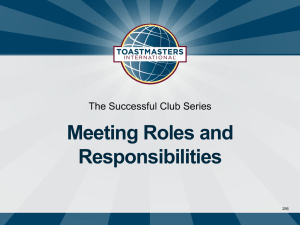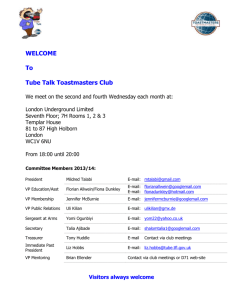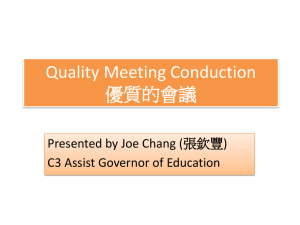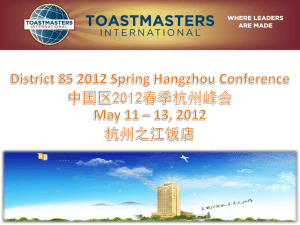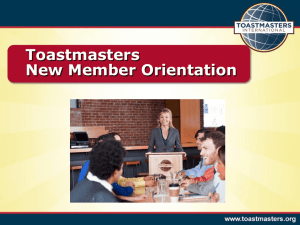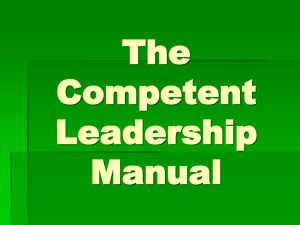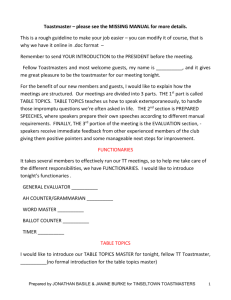Toastmasters CIPro Club #6682 - Gavel And Glass Toastmasters
advertisement
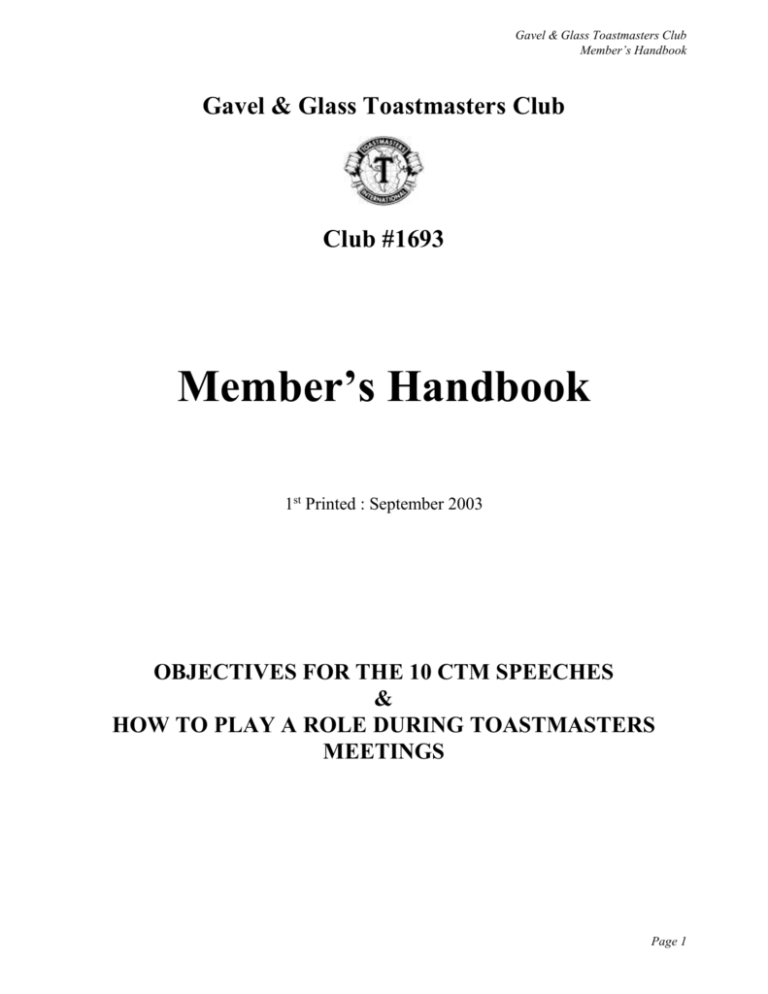
Gavel & Glass Toastmasters Club Member’s Handbook Gavel & Glass Toastmasters Club Club #1693 Member’s Handbook 1st Printed : September 2003 OBJECTIVES FOR THE 10 CTM SPEECHES & HOW TO PLAY A ROLE DURING TOASTMASTERS MEETINGS Page 1 Gavel & Glass Toastmasters Club Member’s Handbook The Club is committed to helping every member. Every member should commit to helping each other. Use the resources wisely & have fun. J. C. Page 2 Gavel & Glass Toastmasters Club Member’s Handbook PREFACE While there are many similarities, each Toastmasters Club carries out their meetings differently. The following describe how regular club meetings are conducted at the Gavel & Glass Toastmasters Club. The Chairman and the Club President may wish to change the standard meeting format to allow for special events. Toastmasters Clubs in our area follow pretty much the same agenda format and protocol. If you visit clubs outside our area, you will notice the format will vary. You are encouraged you to visit other club and experience the variety. The material used in this document was gathered from a number of handouts originally edited by Gordon H. Aue for the Richmond Hill Toastmasters #1963 Club. It is further adopted and edited by Joe Chang for Toastmasters CIPro Club #6682. And again further adopted and edited by Chedmund Lee for Gavel & Glass Toastmaster Club #1693. Page 3 Gavel & Glass Toastmasters Club Member’s Handbook CONTENTS 1) BASIC COMMUNICATION & LEADERSHIP MANUAL OBJECTIVES ....................... 4 2) PROFESSIONAL CONDUCT AS A MEMBER OF TOASTMASTERS ........................ 6 3) HOW TO ACT AS SERGEANT-AT-ARMS .................................................................. 7 4) HOW TO ACT AS TIMER ............................................................................................ 7 5) HOW TO ACT AS GRAMMARIAN .............................................................................. 8 6) HOW TO ACT AS PARLIAMENTARIAN ..................................................................... 8 7) HOW TO ACT AS QUIZ & JOKE MASTER ................................................................ 8 8) HOW TO GIVE A SPEECH .......................................................................................... 8 9) HOW TO PRESENT THE WORD OF THE DAY.......................................................... 9 10) HOW TO PRESENT A VIEWPOINT ............................................................................ 9 11) PARTICIPATING AT THE HEAD TABLE .................................................................. 10 12) THE ROLE OF THE CHAIRMAN ............................................................................... 11 13) HOW TO PARTICIPATE IN A BUSINESS SESSION................................................ 14 14) THE ROLE OF THE TABLE TOPICS MASTER ........................................................ 16 15) THE ROLE OF THE TOASTMASTER ....................................................................... 19 16) THE ROLE OF THE GENERAL EVALUATOR.......................................................... 21 17) APPENDIX ................................................................................................................. 23 1) BASIC COMMUNICATION & LEADERSHIP MANUAL OBJECTIVES 1. The Ice Breaker To begin speaking before an audience Page 4 Gavel & Glass Toastmasters Club Member’s Handbook - To help you understand the audience To help you understand what areas require particular emphasis in your speaking development To introduce yourself to your fellow club members Time: 4-6 minutes 2. Be In Earnest To convince the audience of your earnestness, sincerity, and conviction on a subject you thoroughly understand To confront and control any nervousness you may have Time: 5-7 minutes 3. Organize Your Speech To organize your thoughts into a logical sequence which leads the audience to a clearly defined goal To build a speech outline which includes an opening body and conclusion Time: 5-7 minutes 4. Show What You Mean To learn the value of gestures and body movements as part of a speech To explore the different ways of using body language To develop a sense of timing and natural, smooth body movement Time: 5-7 minutes 5. Vocal Variety To explore the use of voice volume, pitch, rate and quality as assets to your speaking To apply the principles of a well-developed voice to a particular speech Time: 5-7 minutes 6. Work With Words To gain an understanding of the functions and uses of the spoken word To select precisely the right words required to communicate your ideas clearly, vividly and appropriately To avoid common mistakes in word use Time: 5-7 minutes 7. Apply Your Skills To bring together and apply the communication skills you have learned in the preceding projects To organize your speech in a logical manner following one of the suggested outlines To research the facts needed to support your progress To make a personal evaluation of your progress Time: 5-7 minutes Make It Persuasive To present a talk persuading the audience to modify their feelings, beliefs or actions to agree with yours To effect this persuasion by appealing to the audience’s self-interest, building a 8. Page 5 Gavel & Glass Toastmasters Club Member’s Handbook - logical foundation for belief and arousing emotional commitment to your cause Time: 5-7 minutes 9. Speak With Knowledge To gather accurate up-to-date information on a subject so you can expand your knowledge and that of your audience To write a speech based on the insights gained from your research To read the speech before the audience in a lively, interesting and meaningful manner Time: 7- minutes + or - 30 seconds 10. Inspire Your Audience To understand the mood and feelings of your audience on a particular occasion To put those feelings into words and inspire the audience, using all the techniques you have learned so far Time: 8-10 minutes 2) PROFESSIONAL CONDUCT AS A MEMBER OF TOASTMASTERS Avoid the use of profanity or slang. Do not speak about sex, religion or politics. Page 6 Gavel & Glass Toastmasters Club Member’s Handbook 3) Conduct yourself in both manner and appearance as if you were in a boardroom. Be helpful and assist when required at all meetings. Be encouraging to others at meetings. Make our guests feel welcome before, during and after meetings, especially during the break. Arrive early to avoid interrupting the meeting. HOW TO ACT AS SERGEANT-AT-ARMS To ensure a meeting runs smoothly and professionally, the Sergeant-At-Arms has an important and busy role. There are a number of tasks to be performed before, during and after the meeting. Don’t be shy to ask for assistance from your fellow members. MEETING PREPARATION Arrive at least 30-45 minutes before the meeting. Arrange the room based on the meeting format. Post the Toastmasters signs on all entrances. Setup teapot and snacks for the recess. Spread out name tags for members to pick up. Distribute all paper work (meeting agenda, speech objectives, voting ballots etc.). Get signatures from the meeting officials for all the Award Certificates. LOOKING AFTER THE GUEST(s) Have the Guest(s) sign the guest book. Ask the guest(s) to complete the Guest Information Sheet. Prepare name tag(s) for the guest(s). Assign Toastmaster(s) to introduce the guest(s) AT THE MEETING Announce the number of guest(s) present and the Toastmaster(s) who is assigned to do the introduction. During the business session, if there is any voting take place, you need to act as the official counter. In between activities, gather comments sheets and/or voting ballots. Tally the ballots and complete the Award Certificates with names of the winners. Take the Award Certificates to the Head Table before the award presentation. AFTER THE MEETING Gather all the paper work and put away everything accordingly. Rearrange the room back to its original form. 4) HOW TO ACT AS TIMER Sit where all participants can see the signal device. Familiarize yourself with stopwatch and signal device. Make sure they are in working order. Page 7 Gavel & Glass Toastmasters Club Member’s Handbook You are responsible for timing all speeches and any other section that the head table may request (evaluations, business session). Be prepared to give a report, when requested, of the evening’s times. Return equipment to Sergeant-at-Arms. Below are suggested timings for Table Topics and Prepared Speeches. These will vary based on the preference of the individual controlling that segment of the meeting. Lights Green Amber Red 5) Table Topics (1 minutes) 30 seconds 45 seconds 60 seconds Prepared Speech 2 minutes before maximum 1 minute before maximum On maximum HOW TO ACT AS GRAMMARIAN Prepare for the Word-of-the-Day to be presented at the early part of the meeting. Throughout the meeting, listen to everyone’s usage of this word. The frequency of the word is being used. In addition, write down any awkward use or misuse of the language. (i.e. slang, grammatical errors). Highlight hum(s) and aah(s). If time permits, mention any exceptionally good use of language or vocabulary. 6) 7) 8) HOW TO ACT AS PARLIAMENTARIAN Your responsibility is to assist the chairman during a business session. Be prepared by having a copy of Robert's Rules of Order (parliamentary procedures) open at all times. Give a brief report at the end of the meeting on how you thought the parliamentary procedures were handled. Give any examples or explanations that may be required. (i.e. "We handled it this way because...") HOW TO ACT AS QUIZ & JOKE MASTER Listen to what has been said in the meeting. Pick out some key comments or stories. Test the members’ listening skills by asking 4-5 questions. Provide some fun by telling a short joke to the group. To avoid embarrassment, be sensitive to the choice of material in the joke. HOW TO GIVE A SPEECH Arrive early. Dress in a business like manner (unless using a costume). Find out who your evaluator is and give him/her your manual. Page 8 Gavel & Glass Toastmasters Club Member’s Handbook Share with your evaluator any concerns or areas you want evaluated. Check set up of room and arrange any speaking aids or props. Sit where you have easy access to speaking platform. To begin your speech, acknowledge the Toastmaster (the person who introduced you), your fellow Toastmasters, and the audience. Do not thank the audience at the end of your speech, give a nod to the Toastmaster as an indication that you have completed your speech. Listen intently during your evaluation. Get your manual from your evaluator. Have the Educational Vice-President initial the Record of Assignment in the back of your book. 9) HOW TO PRESENT THE WORD OF THE DAY You have 30 seconds. Introduce a new (or seldom used) word to the members. Present the word in writing for all to see and place it in an area where all members can see it. Pronounce the word. Give a definition of the word. Use the word in a sentence. Encourage the use of the word. Good sources for the word is: dictionary, thesaurus, Readers Digest. 10) HOW TO PRESENT A VIEWPOINT You have two minutes. Prepare a controversial speech on a subject that will arouse discussion. Try not to offend. Note: At the time of print, Presentation of Viewpoint is not part of our regular meeting agenda. Some members have suggested incorporating the presentation of Viewpoint into our regular meeting programme. The Club Executives are looking at this idea. Page 9 Gavel & Glass Toastmasters Club Member’s Handbook 11) PARTICIPATING AT THE HEAD TABLE To participate in the various roles at the head table, it is recommended that the member meet the following criteria: POSITION COMPLETED Table Topics Master #1 Speech Toastmaster #3 Speech General Evaluator #5 Speech Chairman #5 Speech When taking on a position at the head table, please keep in mind that: 1. You are setting an example for your fellow members (particularly those with less experience). 2. You are demonstrating to our guests the level of competence and professionalism you Club has to offer. 3. When being introduced by the Chairman, please stand and be recognized by the audience. Careful preparation and professional conduct will help to achieve meetings that are educational, enjoyable and reflect standards of excellence that we can all take pride in as Toastmasters. Page 10 Gavel & Glass Toastmasters Club Member’s Handbook 12) THE ROLE OF THE CHAIRMAN The Chairman is responsible for the entire programme. For details of the job, refer to the Appendix of the Communication and Leadership Manual. PRIOR TO THE MEETING The Chairman is responsible for confirming the Head Table and all supporting roles (Sergeant-At-Arms, Timer, Grammarian, Parliamentarian, Quiz & Joke Master) one week in advance. Confirm with the Vice-President of Education: the agenda, determine whether there will be any unfinished business (from the Minutes), correspondence, committee reports, induction or special orders of business by checking with members of the Executive Committee. Prepare your opening remarks in advance. Opening remarks provide an opportunity for the Chairman to inject his/her own thoughts into the meeting; they set the tone for the whole meeting. Be concise. It is the Chairman’s responsibility to introduce the people on the Head Table and he/she should prepare a short introduction for each person. On the agenda, list the speakers in order of least experienced speakers first. Confirm this with the Toastmaster. Have Sergeant-at-Arms distribute the agenda to all members. It is the Chairman’s responsibility to ensure all supporting roles are present before the beginning of the meeting. If necessary, appoint a substitute right away. Ensure that you know who is responsible for all assignments and that they are present, before you call the meeting to order. Check that the lectern, timing lights and other equipment are arranged to your satisfaction. Make sure that a copy of the Parliamentary Procedures is available during the business session. Give a one-minute-warning to the members, then call the meeting to order by rapping with the gavel. AT THE MEETING Call the meeting to order. Page 11 Gavel & Glass Toastmasters Club Member’s Handbook Give the Chairman’s remarks. Introduce Head Table, including yourself. Have guests introduced. Welcome them with a few appropriate comments. State that they are free to participate in any portion of the meeting, except the business session; at the end of the meeting, they will be asked to make a brief comment on how they felt about the meeting. Ask for the Word-of-the-Day. Encourage use of this word. Introduce the Table Topics Master and pass control of the meeting to him/her. After opening the Business Session, ask the Secretary to read the minutes of the last meeting. Once read, the minutes should be adopted as read or amended. Ask for business arising from the minutes. (Other business should be ruled out of order until the appropriate portion of the business session). Ask for any committee reports from those members of the executive who have one to present. Ask for any old business. Ask for any new business. See Page 15, the section in this manual dealing with business sessions and the role of the chairman. Call for a recess. This should normally be done between 8:00 p.m. and 8:15 p.m. The recess should be no more than 10 minutes depending on the length of agenda. Remind members to pay dues to Treasurer. Before reconvening, ensure that the Toastmaster, General Evaluator and Timer are ready and that the evaluators have been assigned for all speakers. Provide a one-minute-warning, then call the meeting to order. Introduce the Toastmaster who will propose the toast and conduct the speaking program and pass control of the meeting to him/her. After the speeches, introduce the General Evaluator who will conduct the speech evaluation portion of the program. He/she introduces the evaluators for the night’s speakers. The individual evaluators will be given two minutes to evaluate the speech of their assigned speaker. After individual evaluations have been completed the General Evaluator then has three minutes to evaluate the meeting. He/she will then return control of the meeting to you. Ask for reports by Timer, Grammarian, Parliamentarian and Quiz & Joke Master. Page 12 Gavel & Glass Toastmasters Club Member’s Handbook Call for presentation of certificates for the Best Table Topics, the Best Speaker, and the Best Evaluator. These must be presented every week. Ask for the following week’s programme reminder from the VP of Education. Ask for comments from visiting Toastmasters and other guests. Ask for any other announcements. Make some brief and appropriate closing remarks and then adjourn the meeting. Always remain standing when you have control of the meeting. Note: Refer to the Appendix for a sample of the Meeting Agenda. Page 13 Gavel & Glass Toastmasters Club Member’s Handbook 13) HOW TO PARTICIPATE IN A BUSINESS SESSION Business sessions are conducted at most club meetings. These give members to the opportunity to (1) deal with club issues, (2) practice parliamentary procedure, and (3) further participate in the meeting. Occasionally, if there is no serious business to discuss, a member makes a motion that is not at all serious to achieve (2) and (3). Parliamentary procedure is based on the principle that the majority rules and the minority have a right to be heard. It allows for an orderly discussion to take place. To learn how to effectively use parliamentary procedure, members may wish to purchase Parliamentary Procedure at a Glance by O. Garfield Jones (approx. $7 - $8). It is based on “Robert's Rules of Order” and may be obtained from your local bookstore or through the club. Described below are the basic principles and typical motions used at a club meeting. Knowing these will help you to understand and participate in the business session. 1. All questions or comments are directed to the chairman. In this way, the chairman can maintain orderly discussion. 2. Main motion - is the main idea before the group. Only one motion can be under discussion by the group at any one time. To make a motion, raise your hand and wait to be recognized by the chairman, then state “Mr./Madame Chairman, I move that..." 3. Amendment - changes a motion before the group votes on it. After being recognized by the chairman, state "I move that we amend the motion by (adding, deleting, substituting) the words --- “The main motion can only be amended twice before a vote must be called (i.e., only one amendment to the amendment is allowed).” 4. To second a motion/amendment - Before proceeding to deal with the motion or amendment, the chairman will ask if any member would second it. If no one seconds the motion/amendment, then no one feels it is reasonable to allow it. Simply raise your hand to second a motion. 5. Rise on a point of information - To ask a question, you may stand up and interrupt someone who is speaking by saying "Mr./Madame Chairman, point of information" then wait until the chairman recognizes you before you begin to speak. 6. Rise on a point of order - The chairman or any member can point out when a motion, person, or remark is out of order. You may stand up and interrupt someone who is speaking. State “Mr./Madame Chairman, point of order”, then wait until the chairman recognizes you before proceeding to speak. 7. A person is out of order if he/she begins speaking without being recognized by the chairman (e.g., when making a motion or amending a motion). Page 14 Gavel & Glass Toastmasters Club Member’s Handbook 8. A remark is out of order if it is insulting or offensive; for example, if Joe calls Mary a liar, Mary can say "Point of order, Mr. Chairman. (waits to be recognized) - I resent being called a liar, it isn’t true." The Chairman would respond “Your point is well taken. Joe, please refrain from attacking the other members”. 9. A motion is out of order if another motion of higher priority is being discussed. For example, suppose that after a motion was made to serve wine during the break, someone else moved that the club hold a speech contest. The second motion is unrelated and cannot be discussed until the issue about serving wine is voted on. 10. Orders of the Day - If any member feels that the business session should be ended so that the group can proceed with the agenda (the order of the day), then he/she may stand and interrupt a speaker, stating "Mr./Madame Chairman, I call for orders of the day" (and then sit down). This does not require a second, and is not debatable or amendable. 11. If no one objects to the member calling "orders of the day", then a vote is taken. A 2/3 majority vote is required - the business session is then closed and the group proceeds with the agenda. AS CHAIRMAN OF THE BUSINESS SESSION The following describes how to deal with a simple motion: When a member makes a motion, ensure that it is stated in proper terms, i.e., “I move that ...” Ask if any member would second the motion, and announce the name of this member (so that the secretary may record it). Ask the mover of the motion if he/she would like to speak for the motion; then give other members the opportunity to speak for the motion. Ask if any members would like to speak against the motion. Page 15 Gavel & Glass Toastmasters Club Member’s Handbook 14) THE ROLE OF THE TABLE TOPICS MASTER The Table Topics portion of the meeting has three major purposes: 1. To ensure that everyone present is given the opportunity to participate in the meeting. 2. To provide some practice in impromptu speaking or in other specialized aspects of speaking. 3. To give the Table Topics Master the experience of organizing and chairing a part of the meeting, and an additional opportunity to make a speech. REFERENCE MATERIAL The Communication and Leadership manual contains some material on “How to Lead as Topics Master.” PRIOR TO THE MEETING Use the reference material and your own ideas to prepare the Table Topic Programme in advance. You can choose from a variety of ideas such as: quotations, current events, newspaper clippings, questions, pantomime, objects, parliamentary procedures, stories and anecdotes suitable for use in a speech, tall tales and so on. You can also use a variety in the method that determines the topic a person receives. For example: Each member chooses an article from an envelope, box or bag. Each member chooses a number, which you will use to provide his or her topic. Members are paired, each choosing a topic for the other. Generally at our club the Table Topics session is scheduled to last between 20-25 minutes. The length of a Table Topics speech is one minute. If the number of participants must be limited (i.e. 30 members, 20 minute time limit) then members already on the agenda (viewpoint, speakers, evaluators) should not participate. Guests should always be given the choice of participating or abstaining. Prepare a 2-3 minute speech on the Table Topics portion of the programme including an explanation of the purpose of Table Topics, the method of choosing a topic and how to present it. Ask the members not to look at their topics until the preceding member has begun to speak. Contact the Sergeant-at-Arms to ask for any special material you may require (such as the blackboard or flipchart). Page 16 Gavel & Glass Toastmasters Club Member’s Handbook HINTS & TIPS Try to choose topics that will be easy enough to speak on so that new member can enjoy Table Topics, yet challenging enough that more seasoned members will find them interesting. FORTUNE COOKIES - Purchase some fortune cookies on the way to the meeting, then have participants explain the fortune inside and its meaning. CONTINUOUS STORY - As Table Topics Master, start a story and then have participants continue it. The first line each member uses must be the last line used by the previous speaker. A PICTURE IS WORTH A THOUSAND WORDS - Give each participant a picture from the daily newspaper, a magazine, or a calendar and have them tell a story. UNUSUAL PHYSICAL OBJECTS - Bring in a box of the most unusual items you can find. Give an object to each participant and ask him or her to sell the object to club members. DEBATE - Ask participant #1 to take the affirmative, participant #2 the negative. OLD SAYINGS - State an "old saying" and ask participants to describe who originated it and how it came about, i.e. "A Stitch In Time Saves Nine"; "The Straw that Broke the Camel's Back". TOASTMASTER TOPICS - Ask members how they felt giving their icebreaker speech, why they joined the organization, how the program has helped them in their personal life, etc. PRESENT AND ACCEPT AWARDS - Have one member present an award, then another member accept the award. Examples would be retirement, best underwater basket weaver of the year, etc. JOB INTERVIEWS - Tell each participant a job they are applying for (Chief Executive Officer, Public Relations Director, Mud Wrestler) and ask why they are the best candidate for the job. ORATIONS - Bring into the meeting a wooden box strong enough to hold the heaviest member and have them come to the front of the room, stand on the box and speak on the subject chosen by you. The above are only suggestions but the topics are limitless - Use your imagination and you will come up with many great ideas. MAKE IT FUN ! Page 17 Gavel & Glass Toastmasters Club Member’s Handbook AT THE MEETING Ensure that any special material required is set up and that the timer is there and ready with the stopwatch. Explain your role and the Table Topics session for the evening with a concise two - three minute speech. Do not forget to give guests the option of joining in or abstaining (but encourage them to participate). Encourage use of the Word-of-the-Day. Advise timer of light sequence required; green light at 40 seconds, amber at 50 seconds and red at one minute. Let members and guests know the value of time and that we should the speaker once he/she has reached one minute and they should stop and sit down and applaud down. Call for questions from the floor. Begin the session with a club member and never a guest. Only if it is absolutely necessary, should you interrupt once the session begins to clarify the rules or otherwise advise speakers. Remain standing during the entire Table Topics session. Remind members to vote for the member presenting the best Table Topic speech. Guests are not eligible for awards. Thank all who participated. Return control of the meeting to the Chairman. Page 18 Gavel & Glass Toastmasters Club Member’s Handbook 15) THE ROLE OF THE TOASTMASTER As Toastmaster, you are responsible for the entire Formal Speaking session. Your primary duty is to act as the host. You have the opportunity to put on an interesting, lively and informative programme for the club. REFERENCE MATERIAL The Communication and Leadership manual contains some material on how to act as Toastmaster. PRIOR TO THE MEETING A week before your assignment as Toastmaster you should make a list of the speakers, speech numbers and General Evaluator at that time. At least one week prior to the day you are to act as Toastmaster, you should confirm each speaker. A few days before the meeting, you should contact each speaker again to get final confirmation of the speech number, the title of the speech, and some background information about the speaker in order to be able to prepare your introduction. Once the speakers have been confirmed, you should contact the General Evaluator to ensure that he/she has an up-to-date list of the speakers and speech numbers so that he/she can organize the evaluation portion of the meeting. Prepare some brief introductory remarks for presentation at the beginning of the Formal Speaking Session. The remarks should be concluded with a toast to the theme of the evening. Prepare brief speeches of introduction for each speaker. It is preferable to have some idea of what the speeches are to be about to ensure that the introductions tie in properly. Your introductions should be brief and to the point, could make some reference to the speakers qualifications, ability and experience, and should include a reference to the speech number and its’ objectives so the audience and the individual evaluator have a basis for their constructive suggestions. Determine the order of speakers bearing in mind the mood of each speech. Generally, the order should be least experienced speakers first. The reason for this is not to intimidate new speakers by having more experienced ones going first. Page 19 Gavel & Glass Toastmasters Club Member’s Handbook AT THE MEETING Before the meeting begins, check to ensure that each scheduled speaker is present and ready to speak. Inform Sergeant-at-Arms if any special set up is required. When you receive control of the meeting from the Chairman, give your introductory remarks. End with a toast to the theme of the evening. Introduce each speaker as they speak. Be sure to state the speech number, the speech objectives, the timing, the title or subject of the speech, and conclude with the name of the speaker. Avoid trite phrases such as, “we have with us tonight” and “at this time.” Use humour only if it suits the occasion and is related to the subject. Remember the four virtues of the introductory speech. Tact - Brevity - Sincerity - Enthusiasm Lead the applause as the speaker moves to the lectern. Remain standing after your introduction until the speaker has acknowledged you (Mr. Toastmaster), then nod acknowledgement and be seated. Give your undivided attention to the speaker. At the end of the speech, thank the speaker. Make a few brief comments that relate to the speech and try to provide some continuity between speakers. It is not appropriate to disagree with any comments a speaker has made, or make any type of evaluation of the speech. Make a few closing remarks, thank the speakers and return control of the meeting to the Chairman. Page 20 Gavel & Glass Toastmasters Club Member’s Handbook 16) THE ROLE OF THE GENERAL EVALUATOR The Evaluation Portion of the meeting is one of the most important parts of the evening. If we are to help ourselves become better speakers we must have honest, constructive evaluations presented in an appropriate manner. The job of the General Evaluator is to act as "Toastmaster" of the Evaluation Portion of the meeting. REFERENCE MATERIAL The booklet "Effective Speech Evaluation" includes material on how to act as General Evaluator. The Communication and Leadership Manual includes tips on what to look for in specific manual speeches to be evaluated. PRIOR TO THE MEETING At least one week prior to the day you are to act as General Evaluator, you should make a list of the names of the speakers and speech numbers and then assign an evaluator to each speaker. A few days before the meeting you should contact the Toastmaster to confirm who will be speaking and their speech numbers. Once you know who will be speaking, you should contact each evaluator assigned to ensure they will be present, and to advise them of the speech they are to evaluate. Prepare some brief introductory remarks for presentation at the beginning of the Evaluation portion of the meeting. (i.e. the purpose or benefits of an evaluation). SUGGESTED TIMES Speech evaluation - 2 minutes General evaluation - 3 - 5 minutes THE GENERAL EVALUATION The General Evaluator should make some general remarks about the meeting itself. These remarks should be organized into a proper speech format with a time of 3 minutes to the maximum of 5 minutes. If guests are present, be sure to explain your role. During this portion of the evaluation, you are free to comment on any aspect of the meeting. Points covered can include the standard of excellence of the meeting, the performance of members of the Club Executive, other programme participants (except speakers), the organization of the meeting, or any other aspect of the meeting to which you can offer some constructive feedback. Page 21 Gavel & Glass Toastmasters Club Member’s Handbook You may want to focus on the following: Pre-program preparation (set-up of room, greeting of guests, availability of materials, guest books, or name badges). Did the meeting start on time? Consider the Chairman’s opening remarks. Were the guests properly introduced. Consider the Table Topics Chairman. Consider the Reading of the Minutes. Consider the business portion of the meeting. (Control of Chairman, Parliamentary practices, wording of motions, executive reports) Consider the Parliamentarian. Consider the Toastmaster (the toast, introduction of speakers, bridging of the speeches and enthusiasm of the Toastmaster). Consider the entire program as to one. Was it an effective meeting? How could it have been improved? Would it impress you as a stranger? Why? Overall, keep in mind that you are essentially presenting your opinion of the meeting as General Evaluator. Phrase your comments accordingly (i.e. I felt that..." or "My impression was that..."). In this way your suggestions will sound positive rather than accusing. (i.e. not "you should have..." or "Never do..."). Offer constructive alternatives. At the conclusion of the general evaluation, present the Smile Award (for the member who showed the greatest sense of humour, made the most people smile or smiled the most at the meeting) and the Spark Plug Award (to the first member to "ignite" the meeting with enthusiasm). Page 22 Gavel & Glass Toastmasters Club Member’s Handbook 17) APPENDIX The samples in this section are to provide some forms of reference to our members when taking on the roles of the Head Table. Members may wish to modify based on their own personal preference. If need, softcopy templates are available from the VP of Education or any Club Officials. Sample of: 1. A Meeting Agenda 2. Script for the Chairman 3. Script for the Table Topic Master 4. Script for the Toastmaster 5. General Evaluator’s Checklist Page 23 Gavel & Glass Toastmasters Club Member’s Handbook Gavel & Glass Toastmaster Club #1693 August 7, 2003 Theme: Ontario 7:00 Call to Order and Introduction of Head Table Table Topic Master Toastmaster General Evaluator Chairperson John Doe John Doe John Doe John Doe 7:05 Guest Introductions 7:10 Introduction of Special Duty Officers Thought of the Day Word of the Day Quizmaster Secretary Timer John Doe John Doe John Doe John Doe John Doe 7:15 Table Topic Session John Doe 7:40 Business Session Minutes of Last Meeting Errors or Omissions Business Arising from Minutes Committee and Officer Reports Old Business and New Business John Doe 7:50 Recess 7:55 Formal Speaking Session: Speaker 1: Lilly Yu Speaker 2: Sheldon Yang Speaker 3: Deanna Yeung (6-8 mins) John Doe 8:25 Formal Evaluation Session: Evaluator 1: Evaluator 2: Leo Liu Evaluator 3: Florence Yu John Doe Quizmaster John Doe 8:45 Presentation of Awards Best Table Topic Speaker John Doe Page 24 Gavel & Glass Toastmasters Club Member’s Handbook Best Speaker Best Evaluator Word of the Day Spark Plug Award 8:50 Other Business Confirmation of Duty Roster Roles 8:55 Guest Comments 9:00 Adjournment John Doe John Doe John Doe John Doe John Doe Your help in cleaning up the meeting room would be much appreciated! Page 25 Gavel & Glass Toastmasters Club Member’s Handbook Chairman Script Call the meeting to order promptly at 7:15 pm I now call this meeting of CIPro Toastmasters to order. Welcome to the meeting. Please take a minute to look through the agenda to see if there are any changes. If there are no changes we will adopt the agenda as is. The theme for this evening is _________________________ I would like to start off the meeting by introducing members of the head table. On my extreme right is our Table Topic Master who is (short introduction of Table Topic Master), ladies and gentlemen your table topic master for this meeting is TM ____________________. (applaud) On my immediate right is our Toastmaster who is (short introduction of Toastmaster) will be leading us through the speaking program tonight, ladies and gentlemen, your Toastmaster for this meeting is TM _____________________. (applaud) On my left is our General Evaluator who is (short introduction of General Evaluator), ladies and gentlemen, your GE for this meeting, TM ____________________. (applaud) Your Chairman for this evening is someone who (short introduction of Chairman), I am your chairman tonight, and my name is ______________________. (Applaud) To help conduct the meeting, we have other officials I will be introducing. Please stand when your name is called. Ladies and gentlemen, please hold your applause until all the officials have been introduced. Our Parliamentarian is TM ______________ Time Keeper is TM ______________ Grammarian is TM _____________ Quiz/Joke Master is TM _______________ Sergeant-at-Arms is TM _______________ (Applaud) Page 26 Gavel & Glass Toastmasters Club Member’s Handbook Please be seated. Mister/Madam Sergeant-at-Arms, do we have any guests this evening. Thank you, Mister/Madam Sergeant-at-Arms, and welcome to all of our guests. Please make yourself at home and feel free to take part in the meeting with the exception of the voting during the business session. To introduce the Word(s)-of-the-Day, I call upon our Grammarian, TM____________________ The next business in order is Table Topics. To explain the purpose of Table Topics and to conduct this part of the meeting I call upon our Table Topic Master, TM _____________________ Thank you, Mister/Madam Table Topic Master We now move to the Business Session. Mister/Madam Secretary, would you read the minutes of the last meeting? (after the minutes have been read) Having heard the minutes, are there any errors or omissions? If there are none, we will adopt the minutes as read. (If there are errors, instruct the secretary to make the adjustments.) If there is no objection we will adopt the minutes as corrected. Are there any committee reports. Is there any unfinished business? Before I turn the floor for open discussion, is there any new business? Is there anything we have to discuss? If there is no further business, I declare the business session closed. We will take a break of 10 minutes, it is now ________, we will reconvene at ______ (before recall give advance warning) Page 27 Gavel & Glass Toastmasters Club Member’s Handbook This meeting will reconvene in one minute. I now call this meeting back to order. The next business in order is the toast of the evening and the Speaking Program. To conduct both of these programs and to introduce the speakers I call upon our Toastmaster of this evening TM _____________________ (after the Speaking program) Thank you, Mister/Madam Toastmaster. The next business in order is the Evaluation Program, to conduct this program and to introduce the Evaluators, I call upon the GE TM ___________________ (after the Evaluation program) Thank you, Mister/Madam General Evaluator. We now come to the Reporting Session. First a report from the Parliamentarian, TM ________________ Thank you, Mister/Madam Parliamentarian. Next a report from the Time Keeper, TM ________________ Thank you, Mister/Madam Time Keeper. Next a report from the Grammarian, TM _______________ Thank you, Mister/Madam Grammarian. Next a report from the Quiz/Joke Master, TM _______________ Thank you, Mister/Madam Quiz/Joke Master. Our next report is from the General Evaluator, Mister/Madam Time Keeper, will you please allow ____ minutes, green at_________, amber at_________, red at_________. To give us a report on the overall meeting, I call upon our GE TM _________________ Thank you, Mister/Madam General Evaluator for your helpful comments and constructive evaluation. It is now time to present the awards. To present the Best Table Topics Speaker Award, our TTM TM ________________ To present the Best Program Speaker Award, our Toastmaster TM ___________________ Now to present the Best Evaluator Award, the Spark Plug and Smile Awards, our GE TM ____________________ Page 28 Gavel & Glass Toastmasters Club Member’s Handbook It is now time to welcome any comments from our guests. Thank you for taking the time to come and visit us and for your valuable comments. Do come and visit us again and if you have questions on becoming a member, do talk to any of the toastmasters. Now I'd like to take an opportunity to confirm the roster for next week. Are there any other business or announcements. If there are none, I call this meeting adjourn. Page 29 Gavel & Glass Toastmasters Club Member’s Handbook Table Topic Master Script Thank you, mister/madam chairman, and welcome to the table topic session. For the benefit of the guests, I will explain the purpose of the table topics program and how it works. The purpose of the table topics program is to improve impromptu speaking - which is the ability to think on your feet and to speak with little or no preparation. Tonight's theme is __________________________________ The rules are simple, an envelope will be passed around containing topics that you have to speak on. When you get the envelop, remove one topic and pass it on, remember you should not look at the topic until the person next to you has begun to speak. The guests are welcome to participate, you will find that this is a great learning experience. Mister/Madam timer, please allow ___ minute for each speaker, green light at ____ sec, amber at ____ and red at ____ minute. so without further delay, let's start with TM _____________________ Thank you for a very interesting table topic session ........ Please remember to complete the ballot for the best table topic speaker of the evening, I now return control of the meeting to the Chairman Page 30 Gavel & Glass Toastmasters Club Member’s Handbook Toastmasters Script Toast of the Evening: Tonight's theme is _______(a 2-3 minutes toast related to the theme of the evening) So let us all rise, raise our glasses and join me in a toast to ____________________________ Please be seated. Speaking Program: 1. Introduce speaker - short intro of speaker - speech number from the manual (CTM or ATM) - speech title - objective of speech - time allowed - name of speaker 2. Applaud and thank speaker 3. Allow 1 minute for members to write down comment/feedback (1 - 3 is repeated for each speaker) Please remember to complete the ballot for the best program speaker of the evening. I now return control of the meeting to the Chairman. Page 31 Gavel & Glass Toastmasters Club Member’s Handbook General Evaluator’s Checklist Topics to Focus Remarks Pre-program Preparation: 1. Setup of the room 2. Greeting of guests 3. Availability of Material 4. Guest book / Name badges Chairman 1. Did the meeting start on time? 2. Consider the Chairman’s opening remarks 3. How was the Introduction of the Head Table? Table Topic Master 1. Was the session filled with fun? 2. How much stimulation was generated? Business Section 1. Reading of the minutes 2. Parliamentary practices 3. Wording of the motions 4. Control of Chairman 5. Executive reports Toastmaster 1. The Toast 2. Introduction of the Speakers 3. Bridging of the speeches 4. The enthusiasm of the Toastmaster Overall Program 1. Speech quality? 2. Value of Evaluation 3. Was it an effective meeting? 4. Comments on the Timer Parliamentarian Quiz and Joke Master Sgt-At-Arms 5. How can the meeting be improved? 6. Your overall impression of the meeting Spark Plug Award / Smile Award Page 32 Gavel & Glass Toastmasters Club Member’s Handbook ( End of Document ) Page 33
